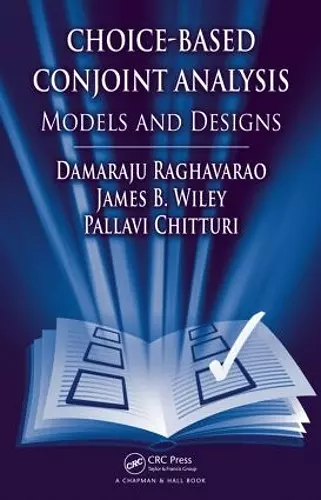Choice-Based Conjoint Analysis
Models and Designs
Damaraju Raghavarao author James B Wiley author Pallavi Chitturi author
Format:Hardback
Publisher:Taylor & Francis Ltd
Published:3rd Aug '10
Currently unavailable, and unfortunately no date known when it will be back

Conjoint analysis (CA) and discrete choice experimentation (DCE) are tools used in marketing, economics, transportation, health, tourism, and other areas to develop and modify products, services, policies, and programs, specifically ones that can be described in terms of attributes. A specific combination of attributes is called a concept profile. Building on the authors’ significant work in the field, Choice-Based Conjoint Analysis: Models and Designs explores the design of experiment (DOE) issues that occur when constructing concept profiles and shows how to modify commonly used designs for solving DCE and CA problems. The authors provide historical and statistical background and discuss the concepts and inference.
The book covers designs appropriate for four classes of DOE problems: (1) attributes in CA and DCE studies are often ordered; (2) studies increasingly are computer-assisted; (3) choice is often influenced by competition; and (4) constraints may exist on attribute levels. Discussion begins with commonly used "generic" designs. The text then presents designs that avoid "dominated" or "dominating" profiles that may occur with ordered attributes and explores the use of orthogonal polynomials to describe relationships between ordered attribute levels and preference. Computer administration entails limited "screen real estate" for presenting concept profiles. The book covers approaches for subsetting attributes and/or levels to "fit" profiles into available "screen real estate." It then discusses strategies for sequential experimentation. Choice also is influenced by the availability of competing alternatives. The book uses availability and cross-effects designs to illustrate the design and analysis of portfolios and shows the relationship between availability effects and interaction effects in analysis of variance models. The last chapter highlights approaches to experimental design in which constraints are imposed on the levels of attributes. These designs provide the means to untangle the pricing and formulation problems in CA and DCE.
It is a pleasure to review this book … For those already familiar with the subject, the text is well worth adding to their book collection …
—Carl M. O’Brien, International Statistical Review, 2012
this book is both educational and interesting to read and is suitable for anyone interested in developing a CA/DCE study. The book is unique, particularly in terms of the breadth and depth of information on experimental designs. The authors did an excellent job providing both contextual and technical details in a form that is both engaging and easy to read. The illustrations are easy to follow and relevant to the related content. … a nice addition to the CA/DCE literature and should be useful to researchers and graduate students alike.
—Mayukh Dass, Journal of the American Statistical Association, December 2011
ISBN: 9781420099966
Dimensions: unknown
Weight: 498g
192 pages